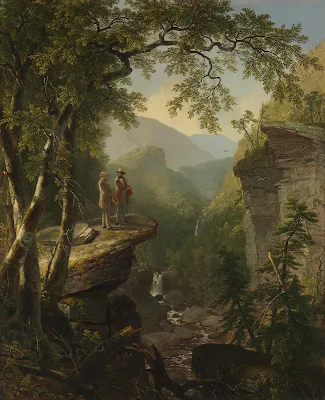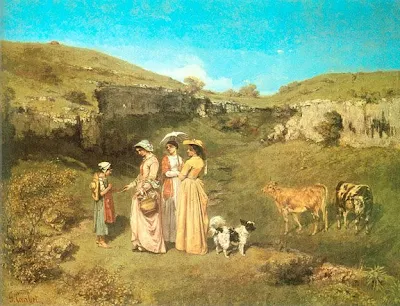Below is an excerpt from the 1994 NY Times Magazine article by Michael Pollan on the subject of the native landscape movement. I came across it in a comment by Susan Harris of Garden Rant under the post Pollan Takes On The Great American Lawn. Although Pollan's article goes on to describe other complications (xenophobia) of the nativist movement, he also touches on some aesthetic themes I've been thinking about for some time, and my focus here is on these.
The quote:
"Environmental pretensions aside, the esthetic of the natural garden would appear to represent an extreme version of the 18th-century picturesque-gardening style, which was the first to maintain that gardens should closely resemble "natural landscapes." It turned out, though, that the natural landscape the picturesque designers strove to emulate was one they found not in nature but in the 17th-century landscape paintings of Claude Lorrain and Nicolas Poussin. Although today's neopicturesque garden designers claim to be emulating actual natural habitats, they too seem to rely on an artistic model. Instead of landscape painting, however, these gardens aspire to the condition of a contemporary nature photograph, an Eliot Porter, say, or an Ansel Adams. Whenever I visit a natural garden I can't help thinking I've walked into the pages of a Sierra Club calendar."
The first "natural picturesque" landscape design that comes to this Brooklyner's mind after reading the above quote is Prospect Park in Brooklyn, NY. When I look at Prospect Park, designed by Olmsted/Vaux, I see emulation of the picturesque, in this case its the picturesque, trancedentalist realism of the Hudson River School style, an American offshoot of the European, largely English, picturesque. Vaux was English, Olmsted had studied in Europe, both well known to Andrew Jackson Downing, the son of a horticulturalist and progenitor of the Hudson Valley's Romantic-Picturesque architectural style out of Newburgh, NY. All three would have been well acquainted with the work of the Hudson River landscape painters. Inherent in the work of all these 19th century landscape practitioners are romantic elements that I cannot ferret out of new native landscape design.
Fallkill Falls, Prospect Park
Kindred Spirits by Asher Durand, 1849
Maybe today's natural gardens are not at all "neopicturesque" as tagged by Pollan, but instead are neo-realist. It was the Realist painters of the 19th century that imagined what was actually there, as opposed to artful conventions and idyllic representation. Of course, Realism was not at all real or virtuous, yet the pretense disturbed many taste-makers, artists, and critics. It was also no coincidence that this realist painting rose alongside, and was influenced by, the invention of photography.
Asher B. Durand's Interior of a Wood, 1850
In the words of Kenneth Clarke, landscape painting "was the chief artistic creation of the 19th century," but the burgeoning process and product of photography (see William Henry Jackson) began a process that eventually pushed painting away from verisimilitude. By the time we see the work of the photographer Ansel Adams, 1902-1984, we see that 19th century romantic landscape eulogized in the stone monuments of the American West. Eliot Porter, 1901–1990, strikes me somewhat like J.J. Audubon with a camera -his interest was almost taxonomical. Pollan is correct to see in Porter's photographs a dialogue with our current conception of landscape "naturalism" because taxonomy is necessarily put into the service of ecology. What Pollan rejects is the photographic conventions represented by the work of Porter or Adams as a model for designing parks and gardens. More precisely, he rejects the notion that our relation to nature as represented by gardens should be mediated by pictures at all. The garden, itself, is the mediating space.
Photography supplanted painting as the choice medium of landscape imagery in the 20th century, but for many photographers the beauty of natural scenery became all too common and suspect -as did the photograph as a means of representing truth. New themes in landscape photography rose out of this: human changes to the landscape, machines in the garden, the overwhelming tide of waste and spoil, beauty and the brown field, and the mundane. Photographers who come to mind are Robert Adams (b. 1937) and New Topographics, Mark Klett (b. 1942) and the Rephotographic Project, Robert Glenn Ketchum (b. 1947), Richard Misrach (b. 1949), Edward Burtynsky (b. 1955), and many others.
If designing "natural" landscapes has been shaped by 20th century photography, then what of the work of these mid-late century photographers? They turn the American wilderness and Old World pastoral conventions on its head, but where does that leave landscape architects and garden designers? After all, they need to create landscapes that attempt resolve the crisis highlighted in the work of these photographers without resorting to old forms.
For many, the ecological restoration landscape -a landscape garden version of the photographic "realism" alluded to in Pollan's essay, has been the answer. Ecological parks and gardens, landscapes of verisimilitude, are a reaction to the conception of a spoiled landscape. I am not as sour on this movement as Michael Pollan may be (or was in 1994). It offers a new motivation for developing new parks in and around our cities. If our conception of urban parks was only 19th century picturesque strolling (Central Park) or 20th century athletic leisure (countless athletic fields, Flushing Meadows-Corona Park), we would find it hard to develop new parks within the limits of available urban land. Ecological-restoration offers motivation for the building of new parks in niches previously undesirable for park development.
There are fifty-one Forever Wild parks throughout New York City. Although NYC Parks chooses to call these "preserves," most are anything but that. These parks are created or "restored" out of spoiled but not yet "developed" regions in each borough. A majority of these parks are on the waterfront, an outgrowth of the decline in commercial shoreline activity, the public enjoyment of water, and a concern for sea level rise and storm surge attenuation. Consider the possibility that a park can function for the public outside of the context of individual or group pleasure, as a protective formation for the public good that also happens to provide habitat for migrating species, strolling, and ecological awareness.
Yet, we shouldn't fool ourselves into thinking we're about to restore nature to a "pure" state in any park. Restoration gardens and parks are created out of a set of intellectual and financial limitations and should only be taken on with humility. Added to the garden is an understanding of our role in changing ecosystems and an awareness of the value of the system to our own needs, beyond accepted forms of aesthetic pleasure.







No comments:
Post a Comment
If I do not respond to your comment right away, it is only because I am busy pulling out buckthorn, creeping charlie, and garlic mustard...